Average Tip Percentages By State: Key Findings
- Delaware leads as the state with the highest average tip percentage (21.5%).
- Conversely, California ranks the lowest in terms of average tip percentage (17.3%).
- The national average tip percentage is approximately 19.39%.
- About 72% of Americans are not in favor of automatic service charges in their restaurant bill — preferring to have control over the tip amount they'll give.
Tipping is a deeply rooted cultural practice in the United States, differing significantly from customs in many other countries.
Here, tips or gratuities are commonly expected in industries like hospitality, as these provide essential support for workers and further encourage quality service.
However, tipping habits differ in each state. That's why in this report, we'll present the average tip percentages by state, highlighting regional differences in tipping-related generosity and norms.
Average Tip Percentages by State
Tipping practices in the United States can vary significantly from state to state, influenced by local customs, economic conditions and service standards.
Nationally, the average tip percentage is about 19.4%, but state-level data shows clear regional variation both above and below that benchmark.

Understanding these variations is essential for both patrons and service employees, as they reflect regional expectations and the importance of gratuity in supporting service industry workers.
The following table outlines the average tip percentages by state, providing insight into what is commonly expected when dining out, enjoying a drink or receiving services across the country.
State | Average Tip Percentage |
|---|---|
Alabama | 19.1% |
Alaska | 18.8% |
Arizona | 19.1% |
Arkansas | 18.5% |
California | 17.3% |
Colorado | 19.5% |
Connecticut | 19.1% |
Delaware | 21.5 % |
Florida | 18.2% |
Georgia | 18.8% |
Hawaii | 18.5% |
Idaho | 19.5% |
Illinois | 19% |
Indiana | 20.4% |
Iowa | 19.8% |
Kansas | 19.8% |
Kentucky | 20.3% |
Louisiana | 18.4 % |
Maine | 19.7% |
Maryland | 19.3% |
Massachusetts | 19.3% |
Michigan | 19.9 % |
Minnesota | 19.0% |
Mississippi | 18.7% |
Missouri | 19.9% |
Montana | 19.9% |
Nebraska | 19.7% |
Nevada | 18.1% |
New Hampshire | 20.4% |
New Jersey | 18.7% |
New Mexico | 18.9% |
New York | 18.7% |
North Carolina | 19.4% |
North Dakota | 19.3% |
Ohio | 20.3% |
Oklahoma | 19% |
Oregon | 19% |
Pennsylvania | 19.8% |
Rhode Island | 20% |
South Carolina | 20% |
South Dakota | 19.4% |
Tennessee | 19.2% |
Texas | 18.7% |
Utah | 18.7% |
Vermont | 19.4% |
Virginia | 19.1% |
Washington | 17.8% |
West Virginia | 20.5% |
Wisconsin | 20% |
Wyoming | 20.3% |
Best States for Tipping
Several states have developed a strong culture of tipping, where patrons frequently show their appreciation for quality service.
Let’s take a closer look at the top five states that have the highest average tip percentages.
1. Delaware (21.5%)
Known for its warm hospitality, Delaware's tipping culture reflects a strong appreciation for service. The state's small-town charm encourages patrons to reward waitstaff generously.
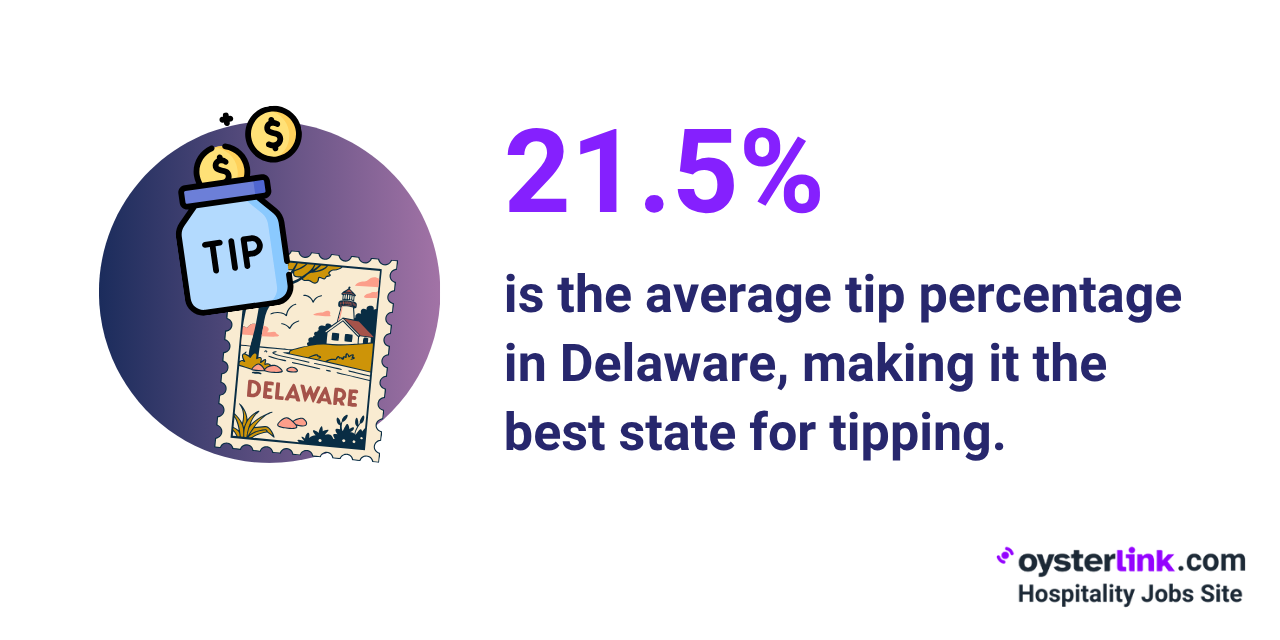
2. West Virginia (20.5%)
West Virginia captures a spirit of community, where locals frequently tip well to support service workers as a way of cultivating neighborly connections.
Additionally, West Virginia allows employers to pay tipped workers a lower base wage under a tip credit system.
This means workers depend heavily on tips to reach a living wage, which encourages customers to give generous gratuities.
3. New Hampshire (20.4%)
Residents and visitors in New Hampshire often express gratitude through tips, recognizing the essential role that service workers play in creating memorable experiences.
This state's tip credit laws also mean tipped employees receive a lower base wage, with tips making up the difference — reinforcing the importance of tipping for workers’ incomes.
4. Indiana (20.4%)
Indiana boasts a favorable tipping culture, influenced by its Midwestern values of kindness and appreciation for hard work in the service industry.
Similar to the other states on this list, the tip credit policy here means workers rely heavily on tips to reach a living wage, encouraging patrons to tip accordingly.
5. Kentucky (20.3%)
The Bluegrass State's tradition of hospitality encourages patrons to tip generously, reflecting respect for service staff who contribute to a welcoming dining experience.
Kentucky’s tipping culture is also shaped by its tip credit wage laws, making gratuities a vital income source for service employees.
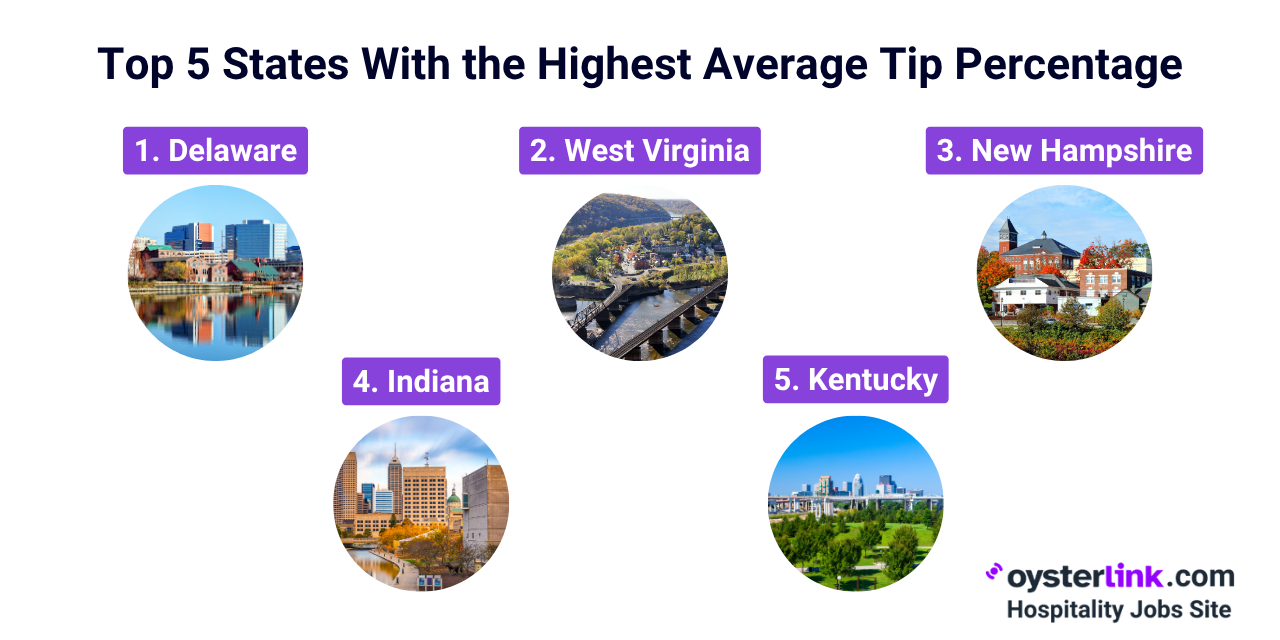
Worst States for Tipping
While some states embrace tipping culture, others demonstrate less generosity in this aspect — but that's not necessarily a bad thing.
Here are the five states where tips tend to be lower than the national average of approximately 19.39%.
1. California (17.3%)
High cost of living and varying wage structures may lead to lower tipping rates compared to other states, alongside a growing trend of service charges automatically added to bills.
Additionally, California is one of the states where tipped workers receive at least the standard minimum wage even before tips.
Because these workers’ base pay is higher and guaranteed, patrons may feel less pressure or obligation to tip large amounts, leading to lower average tip percentages.
2. Washington (17.8%)
Similar to California, Washington requires employers to pay tipped workers the full minimum wage regardless of tips.
This policy reduces workers’ dependence on gratuities as a primary income source, which can contribute to lower tipping percentages.
Moreover, Washington’s large urban centers, where fast-paced and high-volume service is common, may also influence tipping habits by shifting the customer experience toward efficiency rather than personalized service.
3. Nevada (18.1%)
While tourism plays a significant role in Nevada's economy, visitors might not always be well-versed in local tipping customs, leading to inconsistent tipping patterns.
4. Florida (18.2%)
With many service workers relying on tips, it’s surprising to see Florida rank lower. The state's transient population may contribute to this variance in tipping behavior.
5. Texas (18.7%)
A large number of service industry workers in Texas may mean that gratuities can be inconsistent, particularly in sprawling urban areas where competition can dilute the quality of service.
Tipping Etiquette in the US
Tipping is a key aspect of American culture, especially in the service industry. Many employees depend on gratuities to supplement their income.
Understanding the nuances of tipping etiquette can enhance the experience for both patrons and service workers.
Here are some helpful guidelines on how much to tip across various scenarios:
- Dining: In full-service or sit-down restaurants, a tip of 15–20% of the total bill before tax is generally expected. For exceptional service, consider tipping more, especially at upscale establishments.
- Bars: For Bartenders, it's customary to tip $1 to $2 per drink or about 15–20% of the total bill for a tab.
- Hotels: For hotel staff, a tip of $1–2 per bag is standard for Bellhops. Housekeepers typically receive $2–5 per night, depending on the level of service, and Valets should be tipped $1–5 each time they park or retrieve a vehicle.
- Delivery services: For food deliveries, it’s customary to tip $3–$5 or approximately 15–20% of the order total, especially during peak times or inclement weather.
The following chart illustrates how Americans typically tip in various food service settings.
Now that we have established a clear understanding of tipping etiquette, let's explore the hospitality roles where one would be most likely to receive generous tip amounts.
Top 3 Tipped Positions in Restaurants
In the restaurant industry, certain positions typically earn more in tips than others. The top three tipped restaurant positions are:
- Server: Often the primary person of contact for guests, Servers depend heavily on tips. Their ability to provide excellent service directly influences customer satisfaction and, consequently, their earnings.
- Bartender: Bartenders not only mix drinks but also create a social atmosphere, making them popular for tipping. Their direct interaction with patrons often leads to more generous gratuities.
- Valet: In dining establishments that offer Valet services, these staff members frequently receive tips for their speedy service and efficient care in handling customers’ vehicles, particularly in upscale dining or hotel settings.
See also: Can Restaurant Owners Take Tips?
Top 3 Tipped Positions in Hotels & Resorts
In the hospitality sector, certain roles also stand out when it comes to receiving tips:
- Concierge: A Concierge plays a crucial role in enhancing the guest experience. Their knowledge of local attractions and ability to secure reservations often leads to generous tips as guests appreciate their assistance.
- Housekeeper: Housekeepers who provide a clean and comfortable environment for guests can earn additional tips, especially when their efforts are recognized by satisfied customers.
- Bellhop: Responsible for helping guests with their luggage and providing local insights, Bellhops usually receive tips for their service, reflecting the guests' appreciation for a smooth arrival and departure experience.
Service Charges vs. Tipping
In recent years, many establishments have introduced a growing trend of service charges added directly to customer bills.
This change often raises questions about traditional tipping practices and what is expected from patrons. Service charges are a flat fee included to cover gratuity for the staff, particularly in restaurants and catering services.
While intended to simplify the payment process, these charges can lead to confusion about how much to tip on top of the included service fee.
Some patrons may feel that a service charge eliminates the need for additional gratuity, while others might still choose to tip based on the quality of service provided.
Notably, Americans broadly oppose automatic service charges.
About seven-in-ten adults (72%) say they oppose businesses including automatic service charges or tips on customers’ bills, regardless of group size, with half strongly opposing the practice.
Only 10% favor such charges.
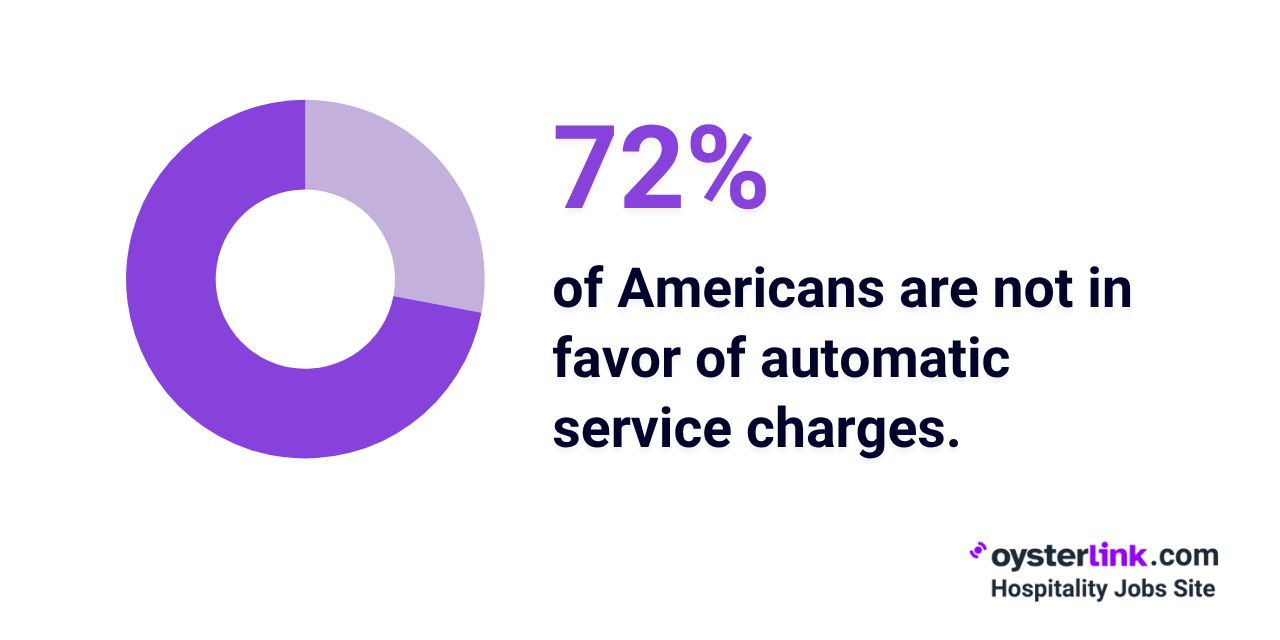
It’s important for consumers to read bills carefully to understand whether a service charge has been applied.
In establishments that implement service charges, it’s still customary in many cases to leave a little extra for exceptional service.
What Tipping Trends Mean for the US Hospitality Workforce
Beyond regional habits and norms, the state-by-state tipping breakdown also highlights the importance of transparency, consistency and fair expectations when it comes to service-based earnings.
For hospitality employees and job seekers, understanding where tipping culture is strongest can influence where and how they pursue opportunities.
As for employers, these trends offer insight into what today’s service staff may expect in return for quality performance.
As the tipping conversation continues to evolve — especially in light of service charges and shifting guest behavior — hospitality businesses need to stay informed and clear about how tips are handled.
Whether you’re managing a restaurant, running a hotel or hiring for seasonal events, being upfront about tipping practices can help attract and retain the best workers.
For more guidance on creating effective job postings that speak directly to tipped workers, check out our article on How To Post Jobs for Tipped Employees.
About OysterLink
OysterLink is a job platform specifically designed for the restaurant and hospitality industry. It features market trends and interviews with celebrities to support career development.
Currently, OysterLink draws over 400,000 monthly visitors and continues to grow.
For more information, visit oysterlink.com or reach out to our PR representative, Ana, at [email protected].
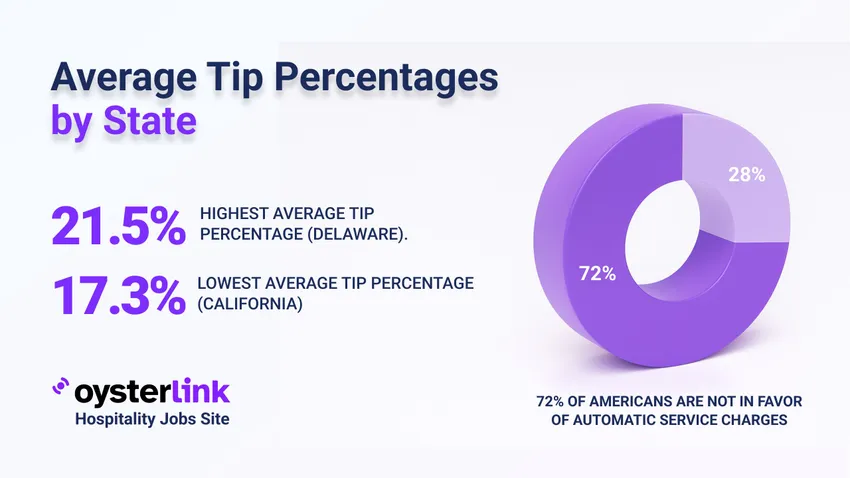




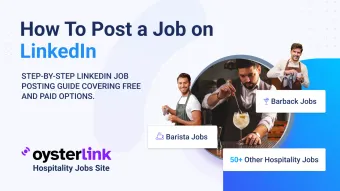




Loading comments...